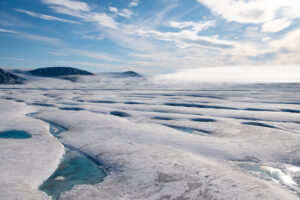
People & Culture
On thin ice: Who “owns” the Arctic?
As the climate heats up, so do talks over land ownership in the Arctic. What does Canadian Arctic Sovereignty look like as the ice melts?
- 4353 words
- 18 minutes
This article is over 5 years old and may contain outdated information.
Science & Tech

How does life survive in one of the most inhospitable places on Earth and why does it matter? Warwick Vincent is finding answers on the bottoms of frozen lakes at the top of the world.
Vincent, a Canada Research Chair in biology at Laval University, studies ice-capped lakes on Ward Hunt Island and the northernmost coast of adjacent Ellesmere Island. Year-round ice cover has sealed off these unusual water bodies from the outside world for millennia. “They’re in the polar desert,” says Vincent. “Precipitation is very low — it looks like a desert —¬ but it’s very cold. In winter we’ve recorded temperatures there as low as -50 C, and an almost complete absence of light. But these lakes are far from dead. There’s a lot going on beneath the surface.”
Some of the lakes contain layers of ancient seawater, left over from when the northern coast emerged from the ocean thousands of years ago, as well as newer fresh water from precipitation and melting. The two types of water never mix. Water temperature increases with depth, the reverse of normal lakes. “[ice-capped lakes] act like greenhouses,” says Vincent, “absorbing energy through the ice. That energy accumulates and is stored. It’s an incredible laboratory: going down through the layers is like reading a textbook.”
In 2014, Vincent and his team cut a hole in the ice of Ward Hunt Lake and lowered a GoPro video camera, taking precautions to avoid contaminating the pristine waters with foreign organisms. Crystal-clear images of the ice filled the monitor screen and, intriguingly, it contained bubbles. That suggested biological activity. As the camera neared the bottom of the lake a remarkable underwater landscape came into view: a luxuriant layer of microbial mats, a carpet of mosses and some mysterious ring-like structures, as yet unidentified.
“There’s one group of organisms that do very well in this kind of environment,” says Vincent. “Cyanobacteria. Their colouring — brown, black or bright-coloured — is actually a form of sunscreen they developed billions of years ago when there was no ozone layer to protect them from ultraviolet radiation. They played an important role in the evolution of life. Then there are picocyanobacteria: take a little sugar cube, divide it by a million, then divide it by a million again, and that’s how small they are. They’re miniaturised solar cells, highly sophisticated. And they don’t just survive in these extreme environments — they thrive.”
An ice-capped lake with the deceptively prosaic name of “Lake A” harbours even tinier life forms known as wild viruses. “They occur naturally,” explains Vincent. “We discovered a unique group of them on Ellesmere Island, and we have evidence that they occur around the globe. In fact, wild viruses are the most widespread and abundant biological particles on Earth. And, because of their role in mobilizing carbon and transferring genetic information from cell to cell, they affect us directly. They’re an essential part of our planet’s life-support system.”
This new knowledge comes from a powerful new technique known as high-throughput DNA analysis, which provides far more information than a microscope and reveals precisely what sort of organisms are present. Its revelations are humbling, says Vincent. “In the past few years we’ve been discovering just how spectacular the biodiversity of planet Earth is. The northern edge of Canada is connected to the rest of the world. We’re exploring for life on Mars, but we really know very little about life on Earth. There’s a lot to learn.”


Are you passionate about Canadian geography?
You can support Canadian Geographic in 3 ways:

People & Culture
As the climate heats up, so do talks over land ownership in the Arctic. What does Canadian Arctic Sovereignty look like as the ice melts?

Environment
The uncertainty and change that's currently disrupting the region dominated the annual meeting's agenda

Environment
What the collapse of the Milne ice shelf and the loss of a rare Arctic ecosystem might teach us about a changing planet

Science & Tech
Celebrating Canadian Innovation Week 2023 by spotlighting the people and organizations designing a better future